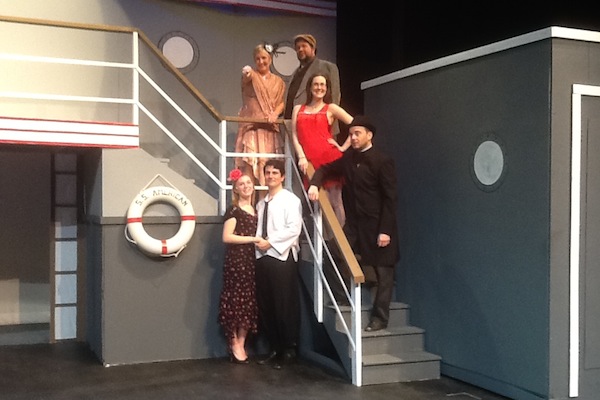
The plot and characters exist mainly as song cues for Cole Porter’s tunes. An evangelist/cabaret singer, Reno Sweeney, sets sails on the S. S. American along with Public Enemy #13, Moonface Martin and Erma, the quintessential gangster’s moll, disguised, respectively, as a reverend and a nun in stiletto heels. Billy Crocker, neophyte stockbroker, stows away trying to prevent his true love, Hope Harcourt, from marrying the tweedy and somewhat twee Lord Oakleigh to satisfy her mother’s societal ambitions. Billy is also trying to dodge his boss, Eli Whitney, as well as the FBI and the ship’s Captain and Purser.
It’s farce played with speed and energy and for a show that began life in the 1930’s, the songs have aged magnificently and almost all of the jokes along with them (my only reservation with the script came with a couple of stereo-typed Chinese characters which the script treats with all of the cringe-worthy condescension of the historical setting of the play).
Cole Porter’s songs, which are stuffed with abandon into the “plot”, are a witty mix of romantic longing and almost surreal wordplay and one-upmanship—they’re closer to Gilbert and Sullivan than to Porter’s contemporary, Irving Berlin. How else to explain a song like “You’re The Top” which goes from “you’re the smile on the Mona Lisa”
to the enthusiastic declaration of “You’re broccoli!”? “Friendship” starts off as a ringing endorsement of its title and gradually turns to a blackly funny and violent anti-endorsement of the same.
Carol Ann Sweeney had more than enough sass to make her Reno carry the day and performed a brassy rendition of the title song. Margaret MacPherson had the requisite sweetness and spunk to make Hope a sympathetic ingénue. Ron Newcombe, as Billy, has the crooner voice of Dick Powell, a ‘30s musical superstar, and gave one of the funniest, most relaxed performances I’ve seen of his yet. His duet with MacPherson was the romantic highlight of the show.
Matt Campbell as Moonface displayed excellent comic timing and a great singing voice, and used both to top effect in his solo number imparting some “old Australian” advice. Stephanie Hennessey as Erma once again deployed her amazing, incandescent ability to disappear into any character she’s assigned with a high-pitched Kewpie doll voice and the body language of a kittenish Mae West. Todd Pettigrew was hilarious as Lord Oakleigh, and his solo number explaining his wild, Gypsy blood was another highlight.
Robert Bailey, as the pompous Captain, and the always welcome David Hutchinson, as the waspish Purser, made a fine comic team. Greg Woodford gave a wonderfully outsized turn to Mr. Whitney, Billy’s boss and Yale man to his core. Joanne Cantwell, as Hope’s mother, did flustery wonders that recalled to mind Margaret Dumont of the Marx Brothers’ comedies.
Out of the supersized supporting cast, I hope to be forgiven for mentioning only two groups of performers—I enjoyed everyone’s work but these individuals always made me smile with every entrance onstage: the quartet of sailors—Cameron Jones, Ronnie Martin, Hugh Toner, and Kevin Yan—appeared to enjoy every second they were onstage (especially when they were flirting with the lovely Erma) and sang and danced with aplomb; the sextet of tap dancers, Frances Alteen, Kimberly Charron, Nicole Drohan, Sarah Morrison, Lauren Turner, and Shealyn Varnes, were also so obviously enjoying plying their craft, which they did superlatively, they were a delight to watch.
Barb Stetter and her little orchestra hit every cue and were musically as tight as any Broadway pit band. Barb Longva aced the massive task of outfitting the cast and made them look like the cast of a Busby Berkley extravaganza. Bruce Cathcart’s set design was big enough to accommodate his big cast but not so busy with detail to detract attention from the performances. With several moveable set pieces it also allowed for many intimate moments.
As the director of all this madness, Cathcart brought out vaudeville-like over the top performances from his eager to please cast. In a technically difficult show like this one, the actors sometimes get lost in the logistics, but Cathcart deftly kept the focus on his characters. The many set changes were accomplished with swiftness and precision and never slowed the frenetic pace of the play.
Anything Goes wraps up at the Boardmore Theatre on the Cape Breton University Campus Sunday, March 3, at 2 pm.

